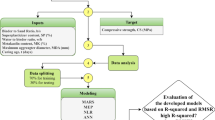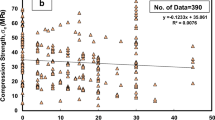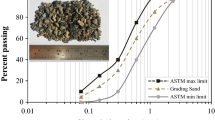Abstract
This research aims to create a reliable model for estimating the compressive strength of cement mortar amended with metakaolin (MK) ingredients and predicting the impact of MK and the maximum diameter of the fine material (MDA) on the compressive strength of the mortar. This study collected 230 datasets from the research with various percentages and curing times. The water-to-binder ratio (w/b) ranges between 0.36 and 0.6 (by the weight of dry cement), sand to-binder ratio of 2–3, the metakaolin content of 0–30%, and the curing time is up to 90 days. Artificial neural network (ANN) models, nonlinear regression (NLR), multi-expression programming (MEP), and multivariate regression spline (MARS) models are the models. The coefficient of determination (R2), root-mean-squared error (RMSE), mean absolute error (MAE), scatter index (SI), standard deviation, and correlation coefficient between measured and predicted compressive strength are some of the evaluation tools that are used to measure the performance of the suggested models. The results show that the MARS model performs better with a high R2 and low RMSE and MAE than MEP, NLR, and ANN models. Based on the dispersion index, the MARS, MEP, and ANN, they have made good predictions about the compressive strength. According to the parametric analysis of MK and MDA, the ANN model effectively anticipated the impact of the previously mentioned model inputs and the ideal MK concentration for enhancing both long- and short-term compressive strength.




















Similar content being viewed by others
Explore related subjects
Discover the latest articles, news and stories from top researchers in related subjects.Availability of data and materials
The data supporting the conclusions of this article are included in the article.
References
Dakwale VA, Pachpor PD, Mahesh S, Namdeo D (2023) Use of metakaolin with polymer modified concrete in repairing of structures. Mater Today Proc 72:9–18
Torres A, Bartlett L, Pilgri C (2017) Effect of foundry waste on the mechanical properties of Portland cement concrete. Constr Build Mater 135:674–681
Damtoft JS, Lukasik J, Herfort D, Sorrentino D, Gartner EM (2008) Sustainable development and climate change initiatives. Cem Concr Res 38(2):115–127
Gustavsson L, Sathre R (2006) Variability in energy and carbon dioxide balances of wood and concrete building materials. Build Environ 41(7):940–951
Gartner E (2004) Industrially interesting approaches to “low-CO2” cements. Cem Concr Res 34(9):1489–1498
Sivakrishna A, Adesina A, Awoyera PO, Kumar KR (2020) Green concrete: a review of recent developments. Mater Today Proc 27:54–58
Rivera F, Martínez P, Castro J, López M (2015) Massive volume fly-ash concrete: a more sustainable material with fly ash replacing cement and aggregates. Cement Concr Compos 63:104–112
Rashad AM (2014) Recycled waste glass as fine aggregate replacement in cementitious materials based on Portland cement. Constr Build Mater 72:340–357
Vyšvařil M, Bayer P, Žižlavský T (2021) Use of spongilites as pozzolanic additives in cement mortars. In: Solid state phenomena, vol 325. Trans Tech Publications Ltd., pp 65–70
Zakrzewski M, Gancarz M, Tvrdá K, Laskowska-Bury J, Domski J (2023) Comparative analysis of waste, steel, and polypropylene microfibers as an additive for cement mortar. Materials 16(4):1625
Vu DD, Stroeven P, Bui VB (2001) Strength and durability aspects of calcined kaolin-blended Portland cement mortar and concrete. Cement Concr Compos 23(6):471–478
Courard L, Darimont A, Schouterden M, Ferauche F, Willem X, Degeimbre R (2003) Durability of mortars modified with metakaolin. Cem Concr Res 33(9):1473–1479
Parande AK, Babu BR, Karthik MA, Kumaar KKD, Palaniswamy N (2008) Study on strength and corrosion performance for steel embedded in metakaolin blended concrete/mortar. Constr Build Mater 22(3):127–134
Sumasree C, Sajja S (2016) Effect of metakaolin and cerafibermix on mechanical and durability properties of mortars. Int J Sci Eng Technol 4(3):501–506
Batis G, Pantazopoulou P, Tsivilis S, Badogiannis E (2005) The effect of metakaolin on the corrosion behavior of cement mortars. Cement Concr Compos 27(1):125–130
Meddah MS, Zitouni S, Belâabes S (2010) Effect of content and particle size distribution of coarse aggregate on the compressive strength of concrete. Constr Build Mater 24(4):505–512
Khaleel OR, Al-Mishhadani SA, Razak HA (2011) The effect of coarse aggregate on fresh and hardened properties of self-compacting concrete (SCC). Procedia Eng 14:805–813
Armaghani DJ, Asteris PG (2021) A comparative study of ANN and ANFIS models for the prediction of cement-based mortar materials compressive strength. Neural Comput Appl 33(9):4501–4532
Mahmood W, Mohammed A (2019) New Vipulanandan pq model for particle size distribution and groutability limits for sandy soils. J Test Eval 48(5):3695–3712. https://doi.org/10.1520/JTE20180606
Qadir W, Ghafor K, Mohammed A (2019) Evaluation the effect of lime on the plastic and hardened properties of cement mortar and quantified using Vipulanandan model. Open Eng 9(1):468–480. https://doi.org/10.1515/eng-2019-0055
Sihag P, Jain P, Kumar M (2018) Modelling of impact of water quality on recharging rate of storm water filter system using various kernel function based regression. Model Earth Syst Environ 4(1):61–68. https://doi.org/10.1007/s40808-017-0410-0
Vipulanandan C, Mohammed A, Samuel RG (2017) Smart bentonite drilling muds modified with iron oxide nanoparticles and characterized based on the electrical resistivity and rheological properties with varying magnetic field strengths and temperatures. In: Offshore technology conference. OTC, p D041S045R005
Ahmed HU, Mostafa RR, Mohammed A, Sihag P, Qadir A (2023) Support vector regression (SVR) and grey wolf optimization (GWO) to predict the compressive strength of GGBFS-based geopolymer concrete. Neural Comput Appl 35(3):2909–2926
Shah MI, Amin MN, Khan K, Niazi MSK, Aslam F, Alyousef R, Javed MF, Mosavi A (2021) Performance evaluation of soft computing for modeling the strength properties of waste substitute green concrete. Sustainability 13(5):2867. https://doi.org/10.3390/su13052867
Abdalla AA, Mohammed AS, Rafiq S, Noaman R, Qadir WS, Ghafor K, Hind ALD, Fairs R (2022) Microstructure, chemical compositions, and soft computing models to evaluate the influence of silicon dioxide and calcium oxide on the compressive strength of cement mortar modified with cement kiln dust. Constr Build Mater 341:127668
Abdalla A, Salih Mohammed A (2022) Surrogate models to predict the long-term compressive strength of cement-based mortar modified with fly ash. Arch Comput Methods Eng pp 1–26
Chand G, Kumar A, Ram S (2022) Comparative study of metakaolin, pumice powder and silica fume in producing treated sustainable recycled coarse aggregate concrete by adopting two-stage mixing. Clean Eng Technol 9:100528
e Silva AAP, Capuzzo VMS, Silva EF, Pereira AMB, e Silva DAP (2022) Evaluation of mechanical properties and microstructure of high-performance mortars with superabsorbent polymers and metakaolin by means of X-ray computed microtomography. J Build Eng 51:104219
Kathirvel P, Anik GA, Kaliyaperumal SRM (2019) Effect of partial replacement of cement with Prosopis juliflora ash on the strength and microstructural characteristics of cement concrete. Constr Build Mater 225:273–282
Vipulanandan C, Krishnamoorti R, Mohammed A, Boncan V, Narvaez G, Head B, Pappas JM (2015) Iron nanoparticle modified smart cement for real time monitoring of ultra deepwater oil well cementing applications. In: Offshore technology conference, OTC, pp. OTC-25842
Ge Z, Wang Y, Nan L, Liu Q (2006) Genetic algorithms based on bintree structure encoding. J Tsinghua Univ pp 10–14
Lopes HS, Weinert WR (2004) A gene expression programming system for time series modeling
Oltean M, Dumitrescu D (2021) Multi expression programming
Searson DP, Leahy DE, Willis MJ (2010) GPTIPS: an open source genetic programming toolbox for multigene symbolic regression. Citeseer
xxx
Mohamad ET, Hajihassani M, Armaghani DJ, Marto A (2012) Simulation of blasting-induced air overpressure by means of artificial neural networks. Int Rev Model Simul 5(6):2501–2506
Fan J, Wu L, Zhang F, Cai H, Ma X, Bai H (2019) Evaluation and development of empirical models for estimating daily and monthly mean daily diffuse horizontal solar radiation for different climatic regions of China. Renew Sustain Energy Rev 105:168–186
En, BS, (2005). 196–1.(2005). Methods of testing cement. Determination of strength. British Standards Institute.
Astm C. 387-Standard specification for packaged. Dry, combined materials for mortar and concrete
Funding
This work had no funding.
Author information
Authors and Affiliations
Corresponding author
Ethics declarations
Conflicts of interest
The authors declare no conflict of interest.
Ethics approval and consent to participate
Not applicable.
Additional information
Publisher's Note
Springer Nature remains neutral with regard to jurisdictional claims in published maps and institutional affiliations.
Rights and permissions
Springer Nature or its licensor (e.g. a society or other partner) holds exclusive rights to this article under a publishing agreement with the author(s) or other rightsholder(s); author self-archiving of the accepted manuscript version of this article is solely governed by the terms of such publishing agreement and applicable law.
About this article
Cite this article
Abdalla, A.A., Mohammed, A.S. The efficiency of hybrid intelligent models to evaluate the effect of the size of sand and clay metakaolin content on various compressive strength ranges of cement mortar. Neural Comput & Applic 36, 6209–6229 (2024). https://doi.org/10.1007/s00521-023-09384-1
Received:
Accepted:
Published:
Issue Date:
DOI: https://doi.org/10.1007/s00521-023-09384-1




